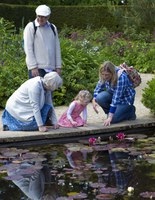Prairie Fare: What are the secrets to a long, healthy life?
(Click an image below to view a high-resolution image that can be downloaded)
I was thinking about longevity the other day. Who doesn’t want a long, healthy life?
As I sipped my coffee at church, I was thinking about a research project we are launching at North Dakota State University. I have included the online survey link with this column.
My 90-plus-year-old church coffee buddy stopped by and joined us at our table. She usually comments on my column of the week.
She inspires me. She lives on her own, drives herself to church and is always dressed stylishly. She’s very witty too.
“How do you come up with new ideas for your column?” she asked.
“I’m always thinking about column ideas,” I replied.
I can be inspired anywhere, any time, I thought to myself. I wonder if she saw the light bulb above my head.
“What is your secret to a long, healthy life?” I asked.
“Well, I smoked for 50 years,” she replied with a saucy grin.
I was not expecting that answer.
“Everyone smoked back then,” she continued. “I stopped smoking about 30 years ago, when my friend had to use an oxygen tank all the time.”
“You must have had some healthy lifestyle practices, such as a nutritious diet and exercise,” I commented.
“We didn’t have cars, so we walked everywhere,” she noted.
“How about nutrition?” I asked. “Did you eat a healthful diet?”
“I suppose we ate better back then,” she said.
I saw a little gleam in her eye.
“One time I got kicked out of a sad movie for crunching on celery too loudly,” she added.
I guess she was a wild woman in her youth, smuggling celery into a movie theater.
“My parents lived into their 90s,” she added.
Genetics certainly play a role in longevity but genetics are not necessarily the only key. Some research has shown that genetics account for about one-fourth of the variation in longevity among people. That leaves three-fourths of longevity due to other factors.
Certainly, our lifestyle plays a key role in many aspects of our health. You probably know these concepts: Eat a balanced, varied diet. Avoid smoking. Avoid excessive alcohol consumption. Get regular physical activity. Get six to eight hours of sleep.
However, is something else linked to longevity that is equally or maybe even more important than some of these lifestyle factors?
Numerous studies have shown that high-quality social relationships with family and friends is important for a long, happy life. Married people have a lower risk of dying from any cause when compared to single people, according a recent study.
If you are single, join communities of people, whether those are faith communities or special interest groups. Being part of groups plays a role in our physical, mental and social wellbeing.
On the other hand, being socially isolated has negative effects on health.
Stay connected with people. Join a fitness group, a music group, a book club or a cooking class so you benefit from the brain-stimulating topics and social interaction. Have coffee with your buddies.
If you are 50 or older, I invite you to take our survey at https://bit.ly/surveydaily50 because it will help us develop better programs and materials for adults. It will take about 15 minutes and will provide us with background to create the best materials we can. We have prize drawings. If you have issues accessing the survey, email me at julie.garden-robinson@ndsu.edu. I appreciate your help.
Invite someone over to help you make this delicious soup. Spring is on the way, but soup is always a welcome food. This flavorful, colorful and fiber-rich soup was the favorite during a recent recipe-testing day, by the way.
Butternut Squash and Lentil Soup
3 garlic cloves
3 carrots
1 large yellow onion
1 leek
1 medium butternut squash
1 bunch kale
2 tablespoons olive oil
1 teaspoon salt
8 cups vegetable stock (no added sodium)
1 ½ cup lentils
1 teaspoon dried thyme
1 teaspoon oregano
1 tablespoon lemon juice
Mince the garlic. Peel and chop the carrots into half-moons. Dice the onion into medium-sized pieces. To prepare the leeks, cut off the dark green leaves and bottom roots, and then slice the leeks in half lengthwise. Then, place each half cut-side down on the cutting board, and chop it into thin half-moons. Rinse thoroughly in a colander to remove any dirt. Peel then chop the butternut squash. Wash and chop the kale. In a large pot over medium heat, heat the olive oil; add the leeks and onions and sauté until softened, about five minutes. Add the carrots and garlic and sauté for three to four minutes until softened. Add the squash, vegetable broth, lentils, thyme, oregano and salt, and bring to a boil. Reduce heat and simmer for about 20 minutes until the lentils and butternut squash are soft (taste test a few). In the last few minutes, add the chopped kale and simmer until tender. Add additional salt and pepper to taste. If desired, stir in the lemon juice.
Makes eight servings. Each serving has 215 calories, 5 grams (g) fat, 12 g protein, 35 g carbohydrate, 11 g fiber and 325 milligrams sodium.
(Julie Garden-Robinson, Ph.D., R.D., L.R.D., is a North Dakota State University Extension food and nutrition specialist and professor in the Department of Health, Nutrition and Exercise Sciences. Follow her on Twitter @jgardenrobinson)
NDSU Agriculture Communication – March 9, 2023
Source: Julie Garden-Robinson, 701-231-7187, julie.garden-robinson@ndsu.edu
Editor: Elizabeth Cronin, 701-231-5391, elizabeth.cronin@ndsu.edu




